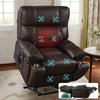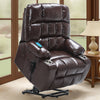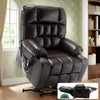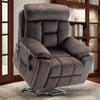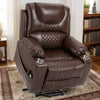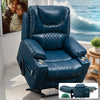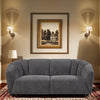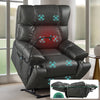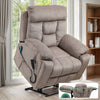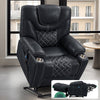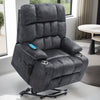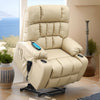Understanding Electric Chair Lifts and Their Benefits
The Basics of Electric Chair Lifts
Electric chair lifts are mobility devices that help people move up and down stairs. They use a motor to lift and lower a seat along a track. These lifts are great for those with limited mobility. They can be installed on straight or curved staircases. Most models can carry up to 300 pounds. Some lifts, like big and tall power recliners, can hold even more weight. Chair lifts run on electricity and have backup batteries. This ensures they work during power outages. The controls are simple, usually just up and down buttons. Many lifts also come with remote controls for easy use.

Why Electric Chair Lifts are a Game-Changer for Mobility
Electric chair lifts greatly improve the lives of those with mobility issues. They allow people to move freely in their homes. This freedom reduces the risk of falls on stairs. It also helps people stay independent longer. Chair lifts can delay the need to move to a single-level home. They make it easier for people to age in place. This can save money and reduce stress. Electric lifts are also helpful for those recovering from surgery. They make it possible to return home sooner. For caregivers, chair lifts reduce the physical strain of helping someone up stairs. This makes caregiving safer and easier.
The Role of Electric Chair Lifts in Home Care
In home care, electric chair lifts play a crucial role. They allow people to stay in their homes longer. This is often better for mental and emotional health. Chair lifts can be part of a larger home care plan. They work well with other mobility aids like walkers or wheelchairs. For those who need full-time care, lifts make it easier for caregivers to move between floors. This can reduce the need for multiple caregivers. Electric lifts also make homes safer for people with conditions like arthritis or heart problems. They reduce the strain of climbing stairs. This can prevent falls and other accidents.
Selecting the Right Electric Chair Lift for Your Needs
Evaluating the Different Types of Electric Chair Lifts
There are several types of electric chair lifts to choose from. Straight stairlifts are the most common. They work on staircases without turns. Curved stairlifts are custom-made for stairs with landings or turns. Outdoor stairlifts are designed to withstand weather. They're good for porches or patios. Standing stairlifts are for those who have trouble sitting. They let users ride in a standing position. Some lifts, like big and tall power recliners, are made for larger users. These can hold more weight and have wider seats. When choosing, consider your staircase type and personal needs.

Important Features to Consider When Selecting an Electric Chair Lift
When picking an electric chair lift, there are key features to look for. Weight capacity is crucial. Make sure the lift can support the user's weight. Seat size and comfort are also important. Look for padded seats and armrests. Swivel seats make getting on and off easier. Folding footrests and armrests save space when the lift isn't in use. Safety features are vital. Look for seatbelts and obstacle sensors. Battery backup ensures the lift works during power outages. Easy-to-use controls are a must. Some lifts offer remote controls or wall-mounted call buttons. Consider the lift's speed and noise level too.
Safety and Accessibility: The Top Priorities for Electric Chair Lifts
Safety is the most important factor in choosing an electric chair lift. Look for models with safety sensors. These stop the lift if something blocks its path. Seatbelts are essential to prevent falls. Many lifts have a key lock to prevent unauthorized use. This is good for homes with children. Accessibility features are also key. Swivel seats make it easier to get on and off safely. Folding rails allow for clear access to the stairs when the lift isn't in use. Some lifts have adjustable seat heights. This helps users with different mobility needs. Easy-to-reach controls are important for all users.
Installation and Maintenance: Best Practices for Electric Chair Lifts in the U.S.
Professional Installation Tips for Electric Chair Lifts
Professional installation is crucial for electric chair lifts. In the U.S., installers should be certified by the manufacturer. They should also follow local building codes. The installation process starts with a home assessment. This ensures the staircase can support the lift. The installer will measure the stairs and plan the track placement. They'll check for obstacles like doorways or radiators. During installation, the track is securely attached to the stairs, not the wall. The installer will test the lift multiple times. They'll also train the user on how to operate it safely. After installation, get a final inspection to ensure everything meets safety standards.

Routine Maintenance and Upkeep of Electric Chair Lifts
Regular maintenance keeps electric chair lifts working safely. Most manufacturers recommend yearly professional check-ups. Between these, users can do simple upkeep. Keep the track clean and free of debris. Wipe it down with a dry cloth regularly. Check that all moving parts move smoothly. Listen for any unusual noises during operation. Keep batteries charged if the lift has a battery backup. Test the lift's safety features monthly. This includes obstacle sensors and emergency stop buttons. Lubricate moving parts as directed in the user manual. Don't overload the lift beyond its weight limit. Report any issues to a professional right away.
Troubleshooting Common Issues with Electric Chair Lifts
Even well-maintained electric chair lifts can have issues. If the lift won't move, check if it's plugged in and turned on. Make sure the safety switches aren't activated. Check if anything is blocking the track. If the lift moves slowly, the batteries might need charging. Strange noises could mean parts need lubrication. If the seat swivel is stiff, it might need adjustment. For beeping sounds, check the user manual for error code meanings. If the remote doesn't work, try changing its batteries. Never try to fix electrical issues yourself. Call a professional for any problems you can't easily solve. Regular maintenance can prevent most common issues.








